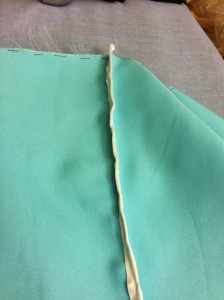No guessers on the last round, but I’m sure you would have figured it out.
So, skirt! I’m using Folkwear 209, the Edwardian skirt pattern that I used for my First Lady Skirt, since it actually works perfectly. Flat in front, volume in the back.
Compare:


Here are the two skirt fabrics:
The hardest part would be cutting the fabric, since cutting a wiggly chiffon on top of poly satin did not sound like fun. But after that, the sewing would be super easy because I’ve done this skirt before, and a skirt is just a bunch of straight seams right?

The fabric cutting did in fact go well. I went slowly and used a million pins. I even remembered that the side and back pieces do have a right side and a wrong side (while they look like symmetrical pieces, they aren’t) and remembered to flip the pattern piece over when cutting the second half.
I needed to baste the layers to make sure the wiggly chiffon stayed on top of the satin nicely. My machine does this annoying as ***** thing where it moves the bottom fabric faster than the top fabric unless I use a million pins (and even then sometimes I end up with puckers) so I actually hand basted all the pieces. Otherwise I knew I would end up with an extra inch of chiffon at the bottom where it got stretched out.
So then the sewing.
Poly satin and metallic-y chiffon fray like no one’s business, so I figured I would use french seams to make sure everything was enclosed. I sewed the first two french seams attaching the sides to the fronts.
Then I realized there needs to be a slit over the right side.

Unpicked the right seam.
Finished the left french seam. It is pretty and enclosed!
Sew the placket bit on the back. While I could never figure it out while just staring at pattern pieces, Folkwear writes incredibly clear instructions and placket goes on smoothly.
I can’t french the back seam since it would bang into the placket on the top, so I figure I’ll just bind this seam with some poly ribbon and call it a day.
Finally can attach the back to the sides!
I sew each seam, trim them, and press them in preparation for sewing the second seam of the french seam.
Then realize I had sewed them right-sides-together, when for french seams you need to do wrong sides together first.

I really didn’t want to unpick those seams, so I said screw it and sewed poly ribbon around those seams too to enclose them.
Then I had to deal with the slit. I’m sure there are a million better ways to have an enclosed seam, with a skirt slit, with a single layer of fabric (probably involving a facing), but I couldn’t figure them out.
So, I dug into my brain and pulled out 18th century hand-sewing techniques. I treated the two layers as individual layers (picking out my lovely hand basting) and turned the raw edges to the inside against each other.
 Where the slit is open over my leg, I just whipped each seam closed from the outside. It’s really not visible unless you are STARING INCREDIBLY CLOSE TO MY LEG.
Where the slit is open over my leg, I just whipped each seam closed from the outside. It’s really not visible unless you are STARING INCREDIBLY CLOSE TO MY LEG.
For the closed part of the seam, whipping all 4 fabric layers together would end up bulky. I used this really nifty running/whip stitch combo thing, that I can’t explain for the life of me. But check out the link because it does a fabulous job.
So here’s what that looks like from the inside:
Hooray fully enclosed skirt slit!
Then I gathered the extra fabric on the back panels and started pinning on my waistband.
Which suddenly wasn’t big enough to get all the way around. But I had mathed really really hard on that waistband and was sure it was the right size.
I mathed again to be sure.
28.5 inches for the waist + 1 inch seam allowance (1/2 inch for each side) + AHAH the extra 2 inches where for the placket ovelap = 31.5 inches. I GOT THIS.
Unpinned the waistband, gathered in an extra inch on each side of the skirt and sewed on the waistband. Whipstitched the inside of the waistband to the skirt. Try it on to bask in my amazingness.
SOMEHOW THE SKIRT IS NOW TWO INCHES TOO SMALL.


Honestly, I still don’t understand this one. If you can figure out my math fail, please let me know. I haven’t decided whether to fix this properly (undo the WHOLE waistband, ungather two inches, add 2 inch extension to the waistband, resew the whole thing) or do it the wrong way (add two inch extension to waistband and call it done, meaning the placket closure is at a way open angle instead of laying flat, and hoping the cape covers this up).
I went to sew the hem, but the chiffon was fraying so badly when I did the usual fold-over-twice that I think a facing might be better so the skirt can’t fray out from under me. But that means I need to cut some bias from the extra poly satin. And if I’m going to use a facing I kinda want to stick some horsehair braid in there to give the hem some stiffness, so I need to buy horsehair braid first.
So yeah, no pictures of the finished skirt today, because I said EFF THIS and started patterning the bodice instead.






You need a walking foot for your machine. It’s an investment you will never regret
Huh, I never thought of that, that is a good idea! I know they are useful for velvet, but shouldn’t a regular foot be good enough for sewing two regular seams together and not need a walking foot all the time? Because I even have this issue on regular seams. Could it be a tension issue?
I originally got my walking foot for sewing fur but have just left it on for just about everything because it just makes my life so much easier. Though I don’t really know munch about sewing so I don’t know if other people who know more are cringing as they read this.
Pingback: Still head over heels for slopers | Avant Garbe
Pingback: A Fantasy Cape + pseudo tutorial | Avant Garbe